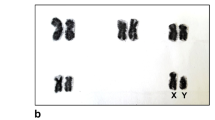Summary
-
1.
The 2n form of Solenobia triquetrella found at Alpe di Melano shows an unpaired X and, in addition, two pairs of special chromosomes differing in size: aa and bb.
-
2.
During the maturation divisions in the egg two different special chromosomes remain permanently bound to each other (ab), while the respective partners remain independent without exception a/b.
-
3.
The distribution of the special chromosomes in the reduction division is at random and is independant of the distribution of the X. Thus the 4 possibilities of combination (ab) + X:a/b + X:(ab)+-: a/b+- (Fig. 2) occur at a 1∶1∶1∶1 ratio.
-
4.
Two interpretations offer themselves:
-
a)
In moth with compound chromosomes (e.g. Phragmatobia fuliginosa, Lymantria monacha) it can be shown, that compound chromosomes are formed in successive steps and that the caryotype is gradually changed (Fig. 4).
The analogous may be true for S. triquetrella. Two different special chromosomes have combined to form a compound chromosome (ab); in this first phase of change, the partners remain independent a/b. Probably a second stage will follow leading to a caryotype with two compound chromosomes, each consisting of two single chromosomes (ab), (ab).
-
b)
More likely is the second possibility, that we are dealing with a reciprocal translocation between two different special chromosomes (Fig. 5). The mutated chromosomes a 1 b 1 are bound together (a 1 b 1), the non-mutated ones remain free a/b.
As a hypothesis we assume that the binding together of a1 and b1 is caused by the constitution of the point of breakage and reunion.
During meiosis both tetrads (a1 b 1) and a/b form a double tetrad, since both have homologous segments (Fig. 5). As shown by direct observations this double tetrad splits into its components (a 1 b 1) and a/b at a 1∶1 ratio.
Similar content being viewed by others
Literatur
Gupta, Y.: Chromosomal studies in some Indian Lepidoptera. Chromosoma (Berl.) 15, 540–561 (1964).
Muller, H. J.: Analysis of the process of structural change in chromosomes of Drosophila. J. Genet. 40, 1–66 (1940).
Narbel-Hofstetter, M.: Cytologie comparée de l'espèce parthénogénétique Luffia ferchaultella et de l'espèce bisexuée L. lapidella. Chromosoma (Berl.) 12, 505–552 (1961). (Hier weitere Lit. über die Zytologie der Psychiden.)
Seiler, J.: Das Verhalten der Geschlechtschromosomen bei Lepidopteren. Arch. Zellforsch. 13, 159–269 (1914);- Geschlechtschromosomen-Untersuchungen an Psychiden. Z. indukt. Abstamm.- u. Vererb.-L. 18, 81–92 (1917). Geschlechtschromosomen-Untersuchungen an Psychiden. I. Experimentelle Beeinflussung der geschlechtsbestimmenden Reifeteilung bei Talaeporia tubulosa. Arch. Zellforsch 15, 249–268 (1920); - III. Chromosomenkoppelungen bei Solenobia pineti. Arch. Zellforsch. 16, 171–216 (1921); - IV. Die Parthenogeese der Psychiden. Biologische und zytologische Beobachtungen. Z. indukt. Abstamm.- u. Vererb.-L. 31, 1–99 (1923). Zytologische Vererbungsstudien an Schmetterlingen. I. Ergebnisse aus der Kreuzung von Schmetterlingsrassen mit verschiedener Chromosomenzahl. Ein Beweis für das Mendeln der Chromosomen. Arch. Klaus-Stift. Vererb.-Forsch. 1, 63–117 (1925). Untersuchungen über die Entstehung der Parthenogenese bei Solenobia triquetrella. I. Mitt.: Die Zytologie der bisexuellen S. triquetrella. Chromosoma (Berl.) 10, 73–114 (1959); - II. Mitt.: Analyse der diploid parthenogenetischen S. triquetrella. Chromosoma (Berl.) 11, 29–102 (1960); - III. Mitt.: Die geographische Verbreitung der drei Rassen von Solenobia triquetrella in der Schweiz und in angrenzenden Ländern. Z. Vererbungsl. 92, 261–316 (1961); -IV. Mitt.: Wie besamen begattete diploid und tetraploid parthenogenetische Weibchen von S. triquetrella ihre Eier ? Schicksal der Richtungskörper im unbesamten und besamten Ei. Z. Vererbungsl. 94, 29–66 (1963);
Seiler, J.: V. Mitt.: Biologische und zytologische Beobachtungen zum Übergang von der diploiden zur tetraploiden Parthenogenese. Chromosoma (Berl.) 15, 503–539 (1964).
—, u. C. B. Haniel: Das verschiedene Verhalten der Chromosomen in Eireifung und Samenreifung von Lymantria monacha. Z. indukt. Abstamm.- u. Vererb.-L. 27, 81–103 (1921).
Suomalainen, E.: The kinetochore and the bivalent structure in the Lepidoptera. Hereditas (Lund) 39, 88–96 (1953); - On polyploidy in animals. Proc. finn. Acad. Sci. 1958, 1–15; - Significance of parthenogenesis in the evolution of insects. Ann. Rev. Entomol. 7, 349–366 (1962).
White, M. J. D.: Animal cytology and evolution, 2. edit. Cambridge: Cambridge University Press 1–454 (1954).
Wolf, B. E.: Zur Karyologie und Furchung bei Cloeon dipterum L. Biol. Zbl. 79, 153–198 (1960).
Author information
Authors and Affiliations
Additional information
Diese Studie sei dem treuen Freund Esko Suomalainen gewidmet.
Die Durchführung dieser Arbeit wurde durch ein Stipendium aus dem Schweizer Nationalfonds ermöglicht.
Rights and permissions
About this article
Cite this article
Seiler, J. Untersuchungen über die Entstehung der Parthenogenese bei Solenobia triquetrella F.R. (Lepidoptera, Psychidae). Chromosoma 16, 463–476 (1965). https://doi.org/10.1007/BF00343174
Received:
Issue Date:
DOI: https://doi.org/10.1007/BF00343174




